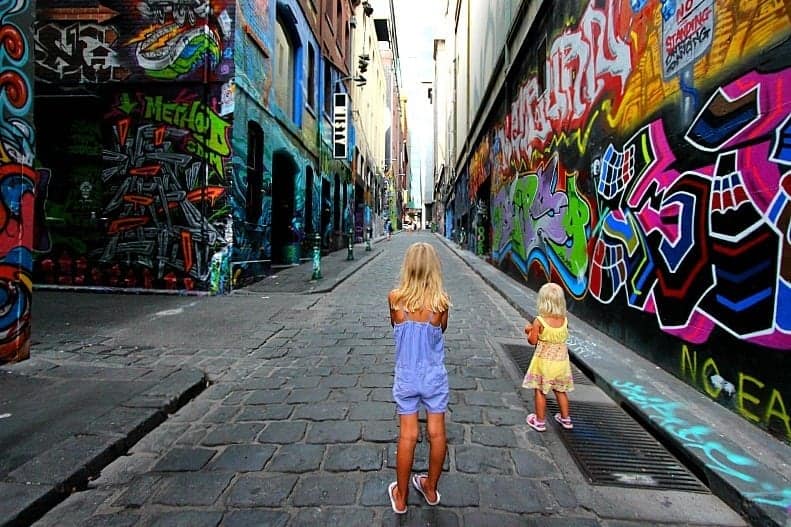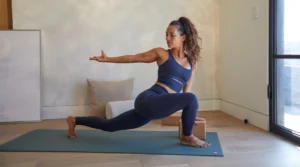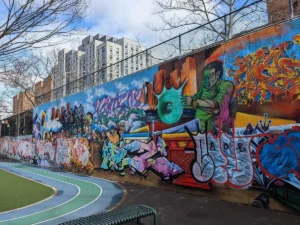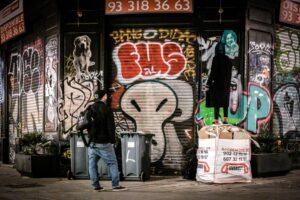Melbourne’s streets pulse with color, stories, and rebellion. The city’s walls, laneways, and even tram lines tell a tale of creativity that’s evolved from gritty graffiti to globally celebrated street art. This article dives deep into how Melbourne earned its title as the “stencil capital of the world,” exploring its history, key moments, and the vibrant culture that makes it a must-visit for art lovers. Whether you’re a local, a tourist, or an artist seeking inspiration, this journey through Melbourne’s street art scene will leave you itching to explore its alleys.
The Roots of Melbourne’s Street Art: A Rebellious Beginning
Melbourne’s street art story starts in the 1970s, when spray cans and youthful defiance collided. Inspired by New York’s graffiti culture, local youth began tagging suburban trains and inner-city walls. It wasn’t about beauty—it was about making a mark, claiming space in a city that felt rigid and controlled.
The Graffiti Wave of the 1970s and 1980s
Graffiti in Melbourne was raw and unpolished, driven by disaffected youth. Tagging names or crude slogans on trains and walls became a way to shout, “I’m here!” This era laid the groundwork for a culture of expression that would later blossom into something more artistic.
The Stencil Revolution: A New Art Form Emerges
By the late 1990s, stencils took over. Unlike freehand graffiti, stencils allowed precision and repeatability, making them perfect for political messages and intricate designs. Melbourne’s artists embraced this, turning the city into a canvas for social commentary and creativity.
The 2000s: Melbourne Becomes the Stencil Capital
The early 2000s marked a turning point. Melbourne’s street art gained international attention, with stencils leading the charge. The city’s colonial-era walls and maze-like laneways became the perfect backdrop for this new art form, earning it the nickname “stencil capital of the world.”
The First Stencil Festival (2004)
In 2004, Melbourne hosted the world’s first stencil festival, showcasing artists like Banksy and local talents such as Ha-Ha and Psalm. This event put Melbourne on the global map, proving street art could be more than vandalism—it could be a cultural force.
Laneways as Living Galleries
Hosier Lane, Union Lane, and other alleyways transformed into open-air galleries. These spaces invited artists to create, experiment, and collaborate, drawing crowds who saw art in motion—constantly changing, never static. It was raw, accessible, and free.
Key Figures and Movements in Melbourne’s Street Art Scene
Melbourne’s street art isn’t just about paint on walls; it’s about the people and movements that shaped it. From individual artists to collectives, the scene thrived on community and innovation.
Pioneers Like Banksy and Local Heroes
While Banksy’s brief stint in Melbourne left iconic stencils, local artists like Vexta and Rone drove the scene forward. Vexta’s Stencil Revolution website and events like See-Saw fostered collaboration, turning street art into a shared language.
The Role of Collectives and Galleries
Collectives like Everfresh Studio and galleries like Early Space gave artists legitimacy. These spaces bridged the gap between street and studio, showing that street art could hang in galleries without losing its edge.
Street Art as Social and Political Commentary
Street art in Melbourne has always been a megaphone for the marginalized. From human rights to environmental issues, artists use walls to spark dialogue and challenge norms.
Murals with a Message
Inspired by Mexican muralists like Diego Rivera, modern Melbourne murals tackle big issues. Pieces addressing climate change or Indigenous rights aren’t just art—they’re calls to action, resonating with passersby.
Graffiti as Protest
Graffiti remains a tool for protest. Whether it’s right-wing slogans or anti-establishment tags, these works shape how neighborhoods are perceived, often stirring debate about social norms.
The Commercialization of Street Art: Boon or Bane?
As street art gained fame, it caught the eye of brands and galleries. This shift brought opportunities but also sparked debates about authenticity.
Pros and Cons of Commercialization
| Pros | Cons |
|---|---|
| Increased visibility for artists | Risk of losing authenticity |
| Professional opportunities | Over-commercialization dilutes messages |
| Funding for community projects | Gentrification of art spaces |
Commercialization opened doors for artists like Rone, whose murals now grace global cities. Yet, some argue it tames the rebellious spirit that defined street art.
Balancing Art and Commerce
Maintaining authenticity is tricky. Artists must navigate brand partnerships while staying true to their roots. Melbourne’s scene thrives by keeping one foot in the streets and one in the gallery.
Iconic Street Art Locations in Melbourne
Melbourne’s street art is inseparable from its locations. These spots are more than walls—they’re cultural landmarks.
Hosier Lane: The Heart of Street Art
Hosier Lane is a kaleidoscope of color and chaos. This narrow alley is a must-visit, with ever-changing murals that reflect the city’s pulse. It’s a living gallery where anyone can watch art evolve.
Fitzroy and Collingwood: The Creative Hub
These suburbs hum with creativity. Fitzroy’s Johnston Street and Collingwood’s back alleys are packed with bold murals and hidden gems, making them perfect for art walks.
Brunswick’s Open-Air Galleries
Brunswick’s lanes, like those behind Dean Sunshine’s factory, showcase vibrant works. These spaces feel like a secret shared between artists and locals, free for all to enjoy.
How Technology Is Shaping Street Art
Technology has crept into Melbourne’s street art, adding new dimensions. From digital mapping to augmented reality, artists are pushing boundaries.
Digital Tools for Street Art
Apps like Procreate help artists sketch designs before hitting the walls. Some even use projectors to map large-scale murals, blending tech with traditional techniques.
Augmented Reality Murals
AR murals let viewers interact with art via smartphones. Scan a mural, and it might come to life with animations or stories, deepening the connection between art and audience.
The City of Melbourne’s Role in Supporting Street Art
The local government has embraced street art, recognizing its cultural value. But it’s a balancing act between support and regulation.
Graffiti Management Policy 2021
The City of Melbourne’s Graffiti Management Policy distinguishes between art and vandalism. While supporting street art, it cracks down on illegal tags, ensuring the city stays vibrant yet orderly.
Commissioned Murals and Festivals
The city occasionally funds murals to brighten dull spaces. Events like the Melbourne Street Art Festival keep the scene alive, inviting artists to transform urban landscapes.
Comparing Melbourne’s Street Art to Other Cities
How does Melbourne stack up against other street art hubs like Berlin or New York? Let’s break it down.
| City | Strengths | Weaknesses |
|---|---|---|
| Melbourne | Stencil dominance, vibrant laneways | Risk of over-commercialization |
| Berlin | Political edge, large-scale murals | Less community focus |
| New York | Graffiti legacy, global influence | High regulation stifles growth |
Melbourne’s focus on stencils and community-driven art sets it apart. While Berlin leans into political statements and New York boasts a gritty legacy, Melbourne’s accessibility and constant evolution make it unique.
People Also Ask (PAA)
What is street art in Melbourne?
Street art in Melbourne includes graffiti, stencils, murals, and installations on public surfaces. It’s a form of visual expression that tackles social, political, or cultural themes, often found in laneways like Hosier Lane.
Where can I find the best street art in Melbourne?
Top spots include Hosier Lane, Fitzroy, Collingwood, and Brunswick. These areas feature ever-changing murals and stencils, with guided tours available for deeper insights. Check out local guides for maps and updates.
Are there street art tours in Melbourne?
Yes, companies like Melbourne Street Art Tours offer guided walks led by artists. These tours dive into the history and stories behind the murals, costing around AUD 60–80 per person.
What tools do street artists use?
Artists use spray paint, stencils, rollers, and digital tools like Procreate. For large murals, scaffolding or projectors may be used. Quality supplies are available at stores like Ironlak in Fitzroy.
Is street art legal in Melbourne?
Legal street art is permitted in designated areas like Hosier Lane or with council approval. Unauthorized graffiti is illegal and may incur fines under the Graffiti Management Policy.
FAQ Section
How did Melbourne become known for street art?
Melbourne’s street art grew from 1970s graffiti, inspired by New York, and evolved with the stencil boom in the 2000s. Events like the 2004 Stencil Festival and supportive local policies cemented its global reputation.
Who are some famous Melbourne street artists?
Artists like Rone, Vexta, and Ha-Ha are local legends. International names like Banksy also left their mark, but Melbourne’s scene thrives on its homegrown talent and collectives like Everfresh.
Can I create street art in Melbourne?
You can create street art in designated areas or with council permission. Check the City of Melbourne’s website for guidelines on legal spaces and permits to avoid fines.
How has street art impacted Melbourne’s culture?
Street art has made Melbourne a global cultural hub, attracting tourists and fostering community dialogue. It’s also boosted local businesses, with art tours and festivals driving foot traffic.
Where can I buy street art supplies in Melbourne?
Shops like Ironlak in Fitzroy and online stores like Montana Cans offer spray paint, stencils, and markers. Local art stores also stock brushes and rollers for mural work.
The Future of Melbourne’s Street Art
Melbourne’s street art scene is far from static. As new artists emerge and technology evolves, the city’s walls will continue to tell stories. But challenges loom—gentrification, over-commercialization, and balancing authenticity with growth.
Emerging Trends
Young artists are blending street art with digital media, creating hybrid works that live both on walls and screens. Collaborations with Indigenous artists are also gaining traction, adding cultural depth.
Preserving the Rebel Spirit
For Melbourne to stay the “stencil capital,” it must nurture its grassroots ethos. Supporting new artists, protecting laneways from development, and fostering community events will keep the scene alive.
Conclusion: Why Melbourne’s Street Art Matters
Melbourne’s street art is more than pretty walls—it’s a living, breathing part of the city’s soul. From its rebellious roots to its global fame, it reflects the creativity, defiance, and community that define Melbourne. Whether you’re strolling Hosier Lane or joining an art tour, you’re stepping into a story that’s still being written. Grab a coffee, hit the laneways, and see what speaks to you—Melbourne’s walls have a lot to say.








